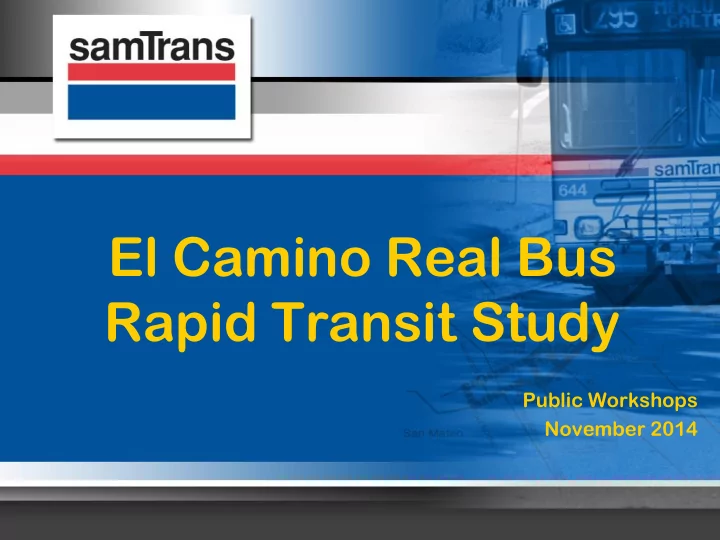

El Camino Real Bus Rapid Transit Study Public Workshops November 2014
What is Bus Rapid Transit? • Rapid Bus − Mixed-flow operations Local Service − Skip-stop service − Signal/street priority Skip-stop Service • Full BRT − Dedicated lanes − Enhanced stations − Rail-like operations − High capital outlay − Challenges 2
Background • Caltrans 2013 Planning Grant − Focus is long-term BRT implementation phasing plan − Short-term Rapid Bus service opportunities − Build off SSP, Grand Boulevard Initiative • An opportunity to − Improve experience for current customers − Attract new riders − Support planned growth per the Grand Blvd. Initiative − Improve options for Caltrain riders • Feasibility study, no binding results 3
Phasing Plan • Short-term operating plan focused on Rapid service • Potential long-term operating plan focused on intensive “Full BRT” service Rapid ECR BRT Long Term Now Short Term 4
Study Goals • Essential system components • Impacts to customer • Ridership forecasts • Capital and operating costs • Funding strategy 5
Service Concepts • How many stops? • How frequent? • What about ECR? • Maximum ridership, minimize costs 6
Rapid Bus Alternatives • ECR: 102-104 stops in each direction • Service concepts − Overlay Rapid over current ECR o Full Overlay with 37 stops (Daly City – Palo Alto) o Truncated Overlay with 32 stops (Daly City – Redwood City) o Truncated Overlay with 23 stops (San Bruno – Redwood City) − Hybrid Route (ECR with fewer stops) o Hybrid A: 76 stops, 10 to 12 minute frequency o Hybrid B: 50 stops, 7.5 to 12 minute frequency 7
Key Study Findings • Ridership Forecasts − Fewer stops = reduced travel time o Can save 15-30 minutes per trip − Transit priority at signals o Can save up to 15 minutes per trip o Technologically viable • Rapid Service can reduce travel times by 25% 8
Rapid Overlay of ECR • ECR ridership in 2020 − 16,600 daily boardings − $14.5 million annual net operating cost o 15% of fixed-route system • Impact of Rapid Bus overlay − Ridership grows 19% to 34% o 19,700 to 22,200 daily boardings o 3,100 to 5,600 new daily boardings − Operating costs increase 34% to 59% o $5.7 million to $10.3 million annually − Capital costs potentially minimal 9
Rapid Hybrid Replaces ECR • Hybrid bus ridership − 25% to 50% fewer stops − Ridership grows 6% to 35% o 17,700 to 22,500 daily boardings o 1,100 to 5,900 new daily boardings − Operating costs increase 8% to 51% o $1.3 million to $8.4 million annually − Capital costs potentially minimal • Difference with Rapid overlay − Ridership growth similar − 18% to 77% lower in operating costs 10
Rapid Bus Capital Costs • Optional features − Enhanced stops ($11 million) o Canopy, benches, windscreen, lighting, signage o Real-time information o About $150,000 per stop − Transit signal priority ($2.4 million) o 120 signals o Reduces travel time by another 15 minutes 11
Full BRT Concept • Potential long-term option − Exclusive bus lanes in each direction − Queue jumps, transit signal priority − 37 stops, maintain ECR − 15-minute frequency for both ECR and BRT • Ridership grows 27% over 2040 ECR − 33,800 daily boardings in 2040 • Operating costs increase $6.9 million annually • Capital costs $100 million for bus lanes, $47 million for 74 enhanced stops • Engineering and other challenges 12
Next Steps • Public input − Public meetings o Nov 13 – South San Francisco Council Chambers o Nov. 18 – SamTrans − GBI Task Force and Working Committee − SamTrans CAC − Cities and others upon request • Transit signal priority − Ongoing coordination with Caltrans, C/CAG − Pursue grants • Monitor system performance and consider within context of Strategic Plan 13
Questions? 14
Recommend
More recommend